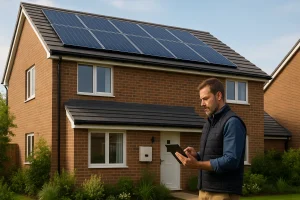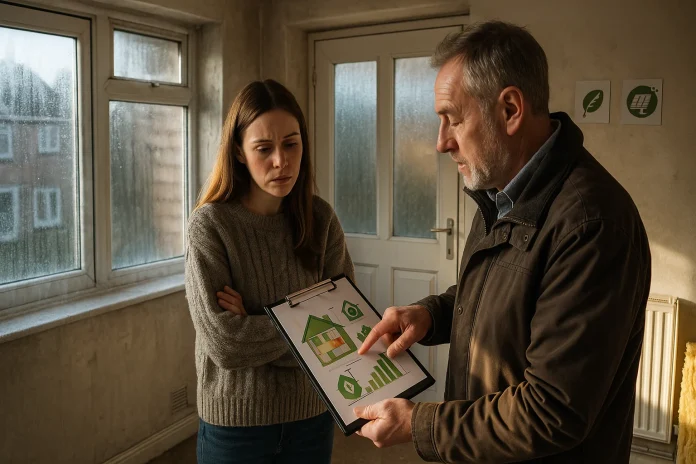Table of Contents
Cold, draughty homes make tenants uncomfortable, drive up energy bills, and reduce property value.
As a private landlord, improving your property’s energy performance helps attract and keep reliable tenants. Warmer, greener homes are easier to manage, cheaper to run, and better for everyone’s health and the planet.
Across the UK, many tenants still face energy payment difficulties during the colder months. By investing in smarter, greener homes, you can ease those financial pressures while improving living conditions for the people who rent from you.
You don’t need to spend a fortune or start from scratch. A few practical housing improvements can make a big difference to both comfort and carbon footprint. Here’s how you can turn a chilly property into a warm, energy-efficient home.
What Can Private Landlords Do to Make Cold Homes Warmer and More Energy-Efficient?
Check Where Heat Escapes

Before making changes, you need to know where your property’s energy is going. Heat often seeps out through poorly sealed walls, thin windows, and loose-fitting doors. That means money wasted every time the heating is on.
Start with an Energy Performance Certificate (EPC) check or an energy audit. This gives you a clear picture of your property’s current rating and highlights the weakest spots. Some landlords also use thermal imaging to identify exactly where heat escapes, offering a clear view of the problem in real time.
Once you’ve gathered the data, you can plan improvements that target the biggest issues first. Think of it as fixing leaks before turning up the tap.
Start With Insulation Improvements
Insulation is the foundation of a warmer home. Without it, even the most efficient boiler won’t help much. Poor insulation allows heat to escape through walls, roofs, and floors, which leaves tenants uncomfortable and pushes up heating bills.
A retrofit installer can help address these issues. They assess your property, identify the most effective targeted energy efficiency measures, and guide you through grant-funded energy-saving schemes.
Partnering with a trusted energy company ensures every improvement meets government standards and delivers lasting results, helping to lower energy costs and improve overall property performance.
Once you’ve had an assessment, focus on practical steps such as loft insulation, cavity wall insulation, or underfloor insulation.
If your property is listed or located in a conservation area, your installer can advise on suitable breathable materials and coordinate with heritage experts where needed.
Better insulation helps maintain steady home temperatures and improves indoor temperature control, keeping tenants warm without constantly turning up the heat.
Upgrade to Efficient Heating Systems
Even with proper insulation, old heating systems can still waste energy. Replacing an outdated boiler with a modern A-rated condensing boiler or a low-carbon heating system like an air-source heat pump can reduce bills and emissions.
It’s also worth fitting smart thermostats and heating controls. These devices let tenants manage heating more precisely, which means less energy waste and fewer complaints about costs.
When planning heating upgrades, think long-term. A reliable, energy-efficient system is an investment in comfort and a selling point that helps keep your property competitive in the rental market.
Choose Energy-Saving Fixtures and Features
Small changes can have a big impact. Upgrading windows to double or triple glazing reduces heat loss immediately. Adding draught excluders, sealant strips, and letterbox brushes helps block cold air from creeping in and keeps rooms consistently warm.
Lighting also plays an important role. Switching to LED bulbs throughout the property lowers electricity use and lasts much longer than traditional bulbs. Encourage tenants to use energy-efficient appliances, or provide them yourself if the property is furnished.
Each small improvement contributes to a home that’s cheaper to run, easier to maintain, and more comfortable throughout the year.
Bring in Renewable Energy

If you’re ready to take a bigger step, renewable energy can transform how your property performs.
Solar panels are a strong option for landlords with suitable roof space. They generate clean electricity, reduce reliance on the grid, and can power communal lighting or shared areas in multi-unit buildings.
You could also explore solar water heating systems with battery storage to hold excess energy for later use. These systems are especially worthwhile if you plan to keep the property for several years, as the savings increase over time.
Check for local grants or a home energy efficiency scheme that can help fund upgrades. Green improvements boost energy performance while increasing your property’s long-term value and strengthening its reputation as a sustainable investment.
Encourage Tenant Involvement
Even the best-insulated home won’t perform well if tenants don’t use energy wisely. Communication is key.
Explain how the heating system works and why it’s important to ventilate rooms while managing heat sensibly.
You could share a quick energy-saving checklist when tenants move in. Simple habits such as turning off lights, shutting doors, and lowering the thermostat slightly can make a noticeable difference.
Some tenants, especially older ones, may also qualify for the Winter Fuel Payment, which helps with heating costs during colder months. Sharing information about available support shows that you care about their comfort and wellbeing.
Regular feedback helps too. Encourage tenants to report draughts, leaks, or faulty radiators early.
Quick fixes prevent bigger problems and maintain thermal comfort throughout the tenancy. Helping tenants use energy efficiently also reduces the risk of energy payment difficulties later on.
Conclusion
Making a cold home warmer and greener doesn’t have to be complicated or costly. Start with insulation, upgrade heating systems, and add renewable energy where possible to create homes that are both comfortable and sustainable.
With engaged tenants, you’ll reduce running costs, cut maintenance issues, and build lasting satisfaction.
Each upgrade moves your property closer to modern energy standards while boosting your tenants’ quality of life and lowering your carbon footprint.
Start planning and turn your properties into warm, efficient homes that stand out for the right reasons.


